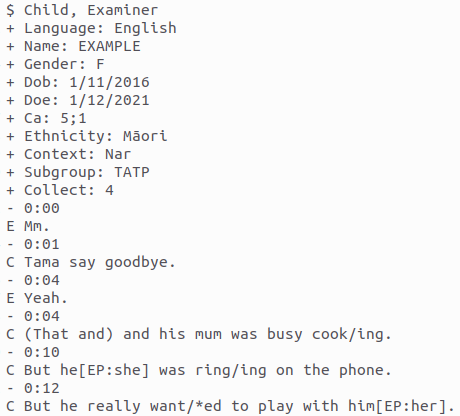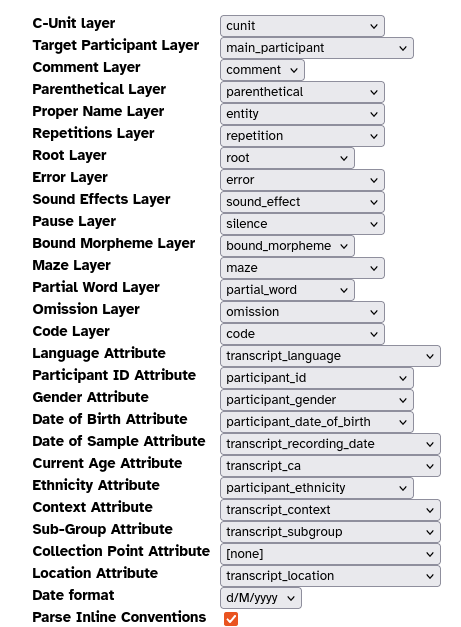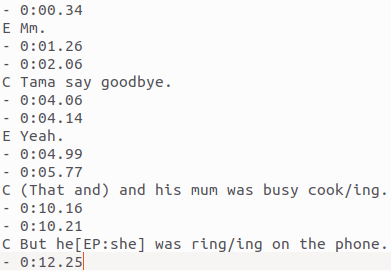SALT Transcripts
“Systematic Analysis of Language Transcripts” software (SALT) is a system designed, at the University of Wisconsin-Madison primarily by Jon F. Miller, for speech/language therapists to help them perform Language Sample Analysis (LSA).
SALT transcripts are essentially plain-text documents that use predefined transcription conventions that cover specification meta-data, as well as textual annotations, as seen in Figure 1.

LaBB-CAT recognises and imports SALT transcripts (files ending in .slt). The transcript conventions cover a closed set of meta-data and annotation types, and many of the defined annotations can be imported into LaBB-CAT, as long as attributes and layers are pre-defined in LaBB-CAT in order to receive the annotations. If layers are not specifed in LaBB-CAT, transcripts can still be imported, but annotation data is necessarily lost during import.
Links between SALT annotations and LaBB-CAT layers must be explicitly configured in LaBB-CAT i.e.
- You must create appropriate word/phrase layers and participant/transcript attributes to hold the SALT annotations you want to parse out of the transcripts.
- Then you must select the converters menu option, and press the configuration button for the SALT transcript converter and specify/save the settings, as shown in Figure 2. (There will be two SALT options in the list, one for importing SALT transcripts, and one for exporting them, but they both use the same settings, so pressing the configuration button for either will have the same effect.)

Meta-data header
The following SALT headers can be imported as participant or transcript attributes into LaBB-CAT:
ParticipantIdLanguageGenderDob- date of birthDoe- date of sampleEthnicityContext- sampling contextSubgroup- Subgroup/storyCollect- collection point numberLocation- place of sample
The assumed format for date values (Dob/Doe) – i.e. whether month or day comes first, and whether the year has two or four digits – is specified by the SALT converter’s Date format setting. However, dates are stored by LaBB-CAT in ISO format - i.e. yyyy-MM-dd
Word tag annotations
The following annotations on words can be extracted into word layers if desired (when setting up each word layer to receive the tags, ensure with ‘Alignment’ set to None):
- Root - word stems marked with
|, e.g.wented|went - Bound Morpheme - affixes marked with
/e.g.ring/ing,wante/*ed - Partial Word - cutoffs suffixed with
*e.g.ever* everybody
Other in-situ annotations
The following annotations, which can span multiple words, or do not apply directly to words, can be extracted into phrase layers if desired:
- C-Unit - i.e. divisions into utterance based on where full-stops/periods and other specific punctuation appear in the transcript
- Parenthetical - enclosed in
((and))
e.g.the boy ((I can/'t remember his name)) left - Proper Name - multi-word names delimited by
_
e.g.Mr_Jones
– these are split into individual tokens where the_delimiters occur, which are tagged on the phrase layer specified by the Proper Name Layer setting, if specified. - Repetition - repetitions delimited by
_
e.g.heaps_and_heaps|heaps
– similarly these are tokenised on_and the multiple tokens are tagged on the selected phrase layer. - Error - tags in square brackets, where the tag starts
E
e.g.he[EP:she] wented|went[EO:went]
– these can encompass multiple words, e.g utterance errors[EU] - Code - tags in square brackets, where the tag doesn’t start with
E
e.g.it's your turn to tell the story X[REDACTED] - Sound effect - prefixed by
%
e.g.%yip_yip went Schnitzel_von_Crumm - Pause - prefixed by
:
e.g.um :02 because - Maze - false starts, repetitions, etc. enclosed in
(and)
e.g.(That and) and his mum - Omission - missing words prefixed by
*
e.gcall/ing *on the phone - Comment - enclosed in
{and}
e.g.{pretends to eat}
There is a system span layer that can be used to extract comments. - background noises, etc. - comments that start with a single word followed by a colon can be extracted into their own span layer e.g. comments like
{NOISE:phone ringing}can be mapped at upload time to LaBB-CAT’s noise layer.
Other Settings
Each SALT transcript starts by declaring the IDs of the speakers, the first speaker being the ‘target speaker’. This translates to LaBB-CAT’s concept of a ‘main participant’, and there is a setting called Target Participant Layer making this link explicit.
As previously mentioned, the expected format of dates is specified by the Date format setting. Options are:
M/d/yyyy- month first, four digit yeard/M/yyyy- day first, four digit yearM/d/yy- month first, two digit yeard/M/yy- daye first, two digit year
Also, all of the above annotation parsing can be disabled by un-ticking the Parse Inline Conventions check box. If this is done, then no annotation parsing is done by LaBB-CAT, and all words, codes, pauses, etc. will appear as-is in the word layer, no annotations or tags will be added, and the text on the word layer will not be normalized.
Orthography Normalization
Unless parsing of inline conventions is disabled, the word token spellings are normalized during input, so that the resulting word orthographies are the normal spellings that might be found in dictionaries, recognised by syntactic parsers, etc.
This is to ensure that SALT transcripts can be automatically annotated in LaBB-CAT in the same way that other formats can be.
For example, an utterance in a SALT transcript might look like this:
But he[EP:she] was ring/ing on the phone.In LaBB-CAT, after upload, this utterance will look like this:
But he was ringing on the phone.i.e. the slashes marking morphem boundaries, and any comments, codes, and any other annotations are stripped out, and where possible the spelling are normalised (e.g. smile/ing will become smiling).
If layers have been configured to receive the annotations, then no information is lost; it’s parsed out into separate layers in LaBB-CAT, as seen in Figure 3.

Synchronization
It is imperative that each utterance is bounded by a synchronization time mark - i.e. a line starting with : which specifies the time the utterance occured in the recording.
LaBB-CAT needs utterance start/end times in order to synchronized playback, and also perform automatic annotations that relate the transcript to the audio, like forced alignment.
The SALT transcript conventions generally include examples of time synchronization to the nearest second. However, this is often not accurate enough for some LaBB-CAT processing, and specifying times accurate to the millisecond are recommended, as shown in Figure 4.
